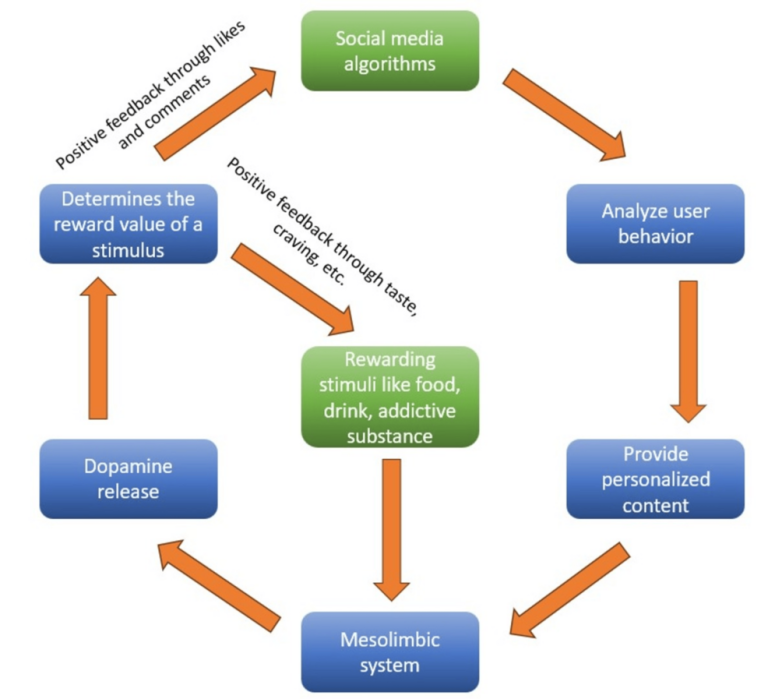Social Media’s Grip on Teen Brains: Exploring the Neurophysiological Impacts and Ethical Quandaries
Social media platforms have become ubiquitous in modern society, permeating nearly every aspect of our lives, particularly for adolescents. While offering benefits like enhanced communication and access to information, these platforms also present significant risks, especially concerning addiction and its impact on the developing teenage brain. Recent research highlights the neurophysiological changes associated with excessive social media use, drawing parallels with substance abuse and gambling addiction. These changes involve the brain’s reward system, emotional regulation centers, and cognitive control networks, contributing to a cycle of compulsive engagement and potentially long-term consequences for mental health and well-being. This burgeoning field of study demands a deeper investigation into the ethical implications of platform design and the responsibility of tech companies in mitigating the addictive potential of their products.
The addictive nature of social media stems from the sophisticated algorithms designed to maximize user engagement. These algorithms exploit the brain’s reward pathways, triggering the release of dopamine, a neurotransmitter associated with pleasure and motivation. Each "like," comment, or notification acts as a small reward, reinforcing the behavior of checking and scrolling. This constant stream of positive reinforcement can lead to dependence, as the brain becomes accustomed to these dopamine rushes and craves more. Over time, this can result in tolerance, where users require increasing levels of engagement to experience the same rewarding feeling, further driving compulsive use. Neuroimaging studies have shown structural and functional changes in the brains of individuals with social media addiction, similar to those observed in substance use disorders. These changes can affect areas involved in impulse control, decision-making, and emotional regulation, making it harder for adolescents to resist the urge to use social media despite negative consequences.
Furthermore, the curated nature of social media feeds, often showcasing idealized versions of reality, can negatively impact adolescent self-esteem and body image. The constant exposure to seemingly perfect lives can lead to social comparison, feelings of inadequacy, and even depression. This is particularly concerning for teenagers, who are already navigating the complex challenges of identity formation and social acceptance. The pressure to maintain an online persona and gain social validation through likes and followers can contribute to anxiety and a fear of missing out (FOMO), further fueling addictive behaviors. The addictive nature of social media is also exacerbated by its accessibility and the constant connectivity it provides. Smartphones have made social media available 24/7, blurring the boundaries between online and offline life and making it harder for teenagers to disconnect and engage in other activities essential for their development.
The ethical implications of these findings are substantial. Tech companies, driven by profit motives, are often accused of prioritizing engagement metrics over user well-being. Their algorithms are designed to be addictive, exploiting vulnerabilities in the human brain to keep users hooked. Critics argue that these companies have a moral obligation to mitigate the harmful effects of their products, particularly on vulnerable populations like teenagers. This includes implementing features that promote healthy usage patterns, such as usage limits, time-out reminders, and educational resources about the potential risks of excessive social media use. Transparency regarding algorithmic design and data collection practices is also crucial, as is supporting research into the long-term effects of social media on adolescent development.
The responsibility for addressing social media addiction doesn’t solely lie with tech companies. Parents, educators, and policymakers also have a vital role to play. Parents need to be aware of the potential risks of excessive social media use and engage in open communication with their children about healthy online habits. Educating teenagers about the persuasive nature of algorithms and the curated reality presented on social media platforms is essential for developing critical thinking skills and promoting media literacy. Schools can incorporate digital citizenship programs into their curriculum, equipping students with the tools to navigate the digital landscape safely and responsibly. Policymakers should consider regulations that protect children and adolescents from the exploitative practices of tech companies, while also promoting research and funding for interventions to address social media addiction.
In conclusion, the addictive potential of social media and its impact on the developing teenage brain presents a significant societal challenge. The neurophysiological changes associated with excessive social media use highlight the need for a multi-pronged approach to address this issue. Tech companies must prioritize user well-being over engagement metrics, implementing features that promote healthy usage patterns and supporting research into the long-term effects of social media on adolescent development. Parents, educators, and policymakers must also play an active role in promoting media literacy, fostering responsible online behavior, and advocating for policies that protect young people from the harmful effects of social media addiction. The future of our youth hinges on our collective ability to navigate this increasingly complex digital landscape and harness the power of technology responsibly.


